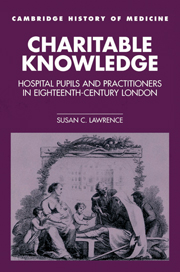Book contents
- Frontmatter
- Contents
- List of tables and figures
- Preface
- 1 Introduction: Hospital medicine in eighteenth-century London
- PART I INSTITUTIONS AND EDUCATION
- 2 The London hospitals: Virtue and value
- 3 The Corporations, licensing, and reform, 1700–1815
- 4 Walking the wards: From apprentices to pupils
- 5 London lecturing: Public knowledge and private courses
- PART II COMMUNITY AND KNOWLEDGE
- Conclusion
- Appendix I London hospital men, 1700–1815
- Appendix II London hospital pupils, 1725–1820
- Appendix III London medical lecturers, 1700–1820
- Index
- Cambridge History of Medicine
5 - London lecturing: Public knowledge and private courses
Published online by Cambridge University Press: 07 May 2010
- Frontmatter
- Contents
- List of tables and figures
- Preface
- 1 Introduction: Hospital medicine in eighteenth-century London
- PART I INSTITUTIONS AND EDUCATION
- 2 The London hospitals: Virtue and value
- 3 The Corporations, licensing, and reform, 1700–1815
- 4 Walking the wards: From apprentices to pupils
- 5 London lecturing: Public knowledge and private courses
- PART II COMMUNITY AND KNOWLEDGE
- Conclusion
- Appendix I London hospital men, 1700–1815
- Appendix II London hospital pupils, 1725–1820
- Appendix III London medical lecturers, 1700–1820
- Index
- Cambridge History of Medicine
Summary
In September of 1769, Mr. Horsley paid for a notice in the Daily Advertiser, one of the newspapers devoted to announcing the wares of the commercial metropolis:
Young Gentlemen desirous of acquiring a competent Knowledge in Anatomy and Surgery, may be privately instructed in each Branch, both scientifically & practically, by Mr. Horsley, Surgeon & Man-Midwife, at Houghton-St., near Clare-Market. As one single course of lectures cannot answer the Student's purpose, Mr. Horsley therefore intends to continue his instruction till his pupils have made sufficient proficiency, by which means, and a regular attendance on the Hospitals, they may soon be initiated into these sciences, without being subject to seven years servitude; a consideration well worthy of the attention of parents or Guardians. For terms enquire as above.
Mr. Horsley's appeal to “Young Gentlemen” encapsulates the themes of this chapter. He offered private instruction that, together with hospital ward-walking, would free “the Student” from the “seven years servitude” of apprenticeship. He promised to teach “both scientifically & practically,” casting anatomy and surgery as “sciences” into which students were “initiated.” Mr. Horsley couched his advertisement for a competitive market. He sold more than “one single course of lectures” at a time when medical lectures had become familiar items in newspaper notices. While it is impossible to estimate Mr. Horsley's success in his teaching career, in 1769 he appeared as a quintessential entrepreneur in the knowledge market of mideighteenth-century London.
- Type
- Chapter
- Information
- Charitable KnowledgeHospital Pupils and Practitioners in Eighteenth-Century London, pp. 162 - 212Publisher: Cambridge University PressPrint publication year: 1996



